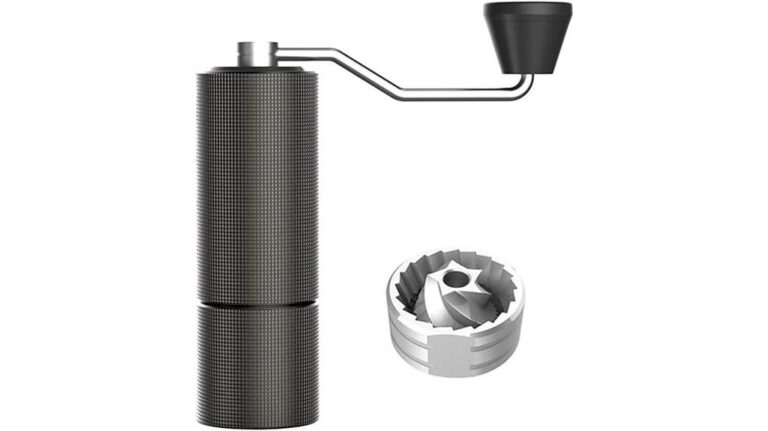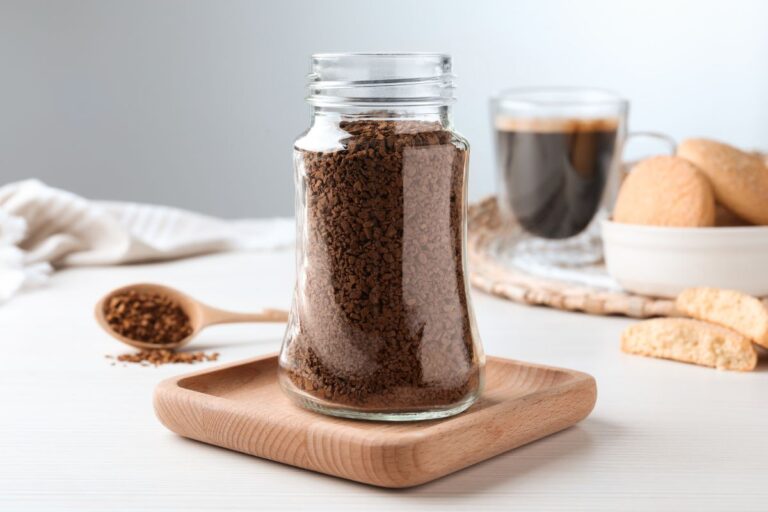The Ross Droplet Technique Explained
Quick Answer: The Ross Droplet Technique is pre-wetting coffee grounds with a small amount of water before grinding. RDT promotes even saturation, reducing uneven extraction caused by carbon dioxide release during the bloom or pre-infusion and increasing flavor extraction during brewing.
Exploring the Breakthrough in Coffee Grinding
Every step of the coffee brewing process is crucial in shaping the final cup’s flavor. Among the various innovations aimed at perfecting this process, the Ross Droplet Technique (RDT) emerges as a standout, revolutionizing the way we grind coffee beans.
Developed by David Ross, this simple yet ingenious method has gained traction among coffee enthusiasts for its ability to enhance the overall quality of the coffee.
The Genesis of RDT
RDT’s journey began as a practical solution to a common problem in coffee grinding: static electricity. Static buildup in coffee grinders often causes grounds to stick to the machine and each other, leading to inconsistent grind sizes and a messier process.
David Ross’s eureka moment came in the form of a small yet significant tweak to the pre-grinding routine – the addition of a few water droplets to the coffee beans.
A Scientific Approach to Coffee Grinding
The science behind RDT is straightforward yet effective. By applying a minimal amount of water to the beans before grinding, RDT creates a pathway for static charges to neutralize. Water, being a good conductor of electricity, allows these static charges to dissipate.
This simple action has a profound impact – it results in coffee grounds that are free from static cling, enabling a cleaner and more consistent grind.
The Science Behind RDT

The Ross Droplet Technique (RDT) is more than just a novel idea; it’s grounded in the basic principles of physics, particularly in addressing the static electricity that often plagues the process of grinding coffee.
The central issue RDT tackles is static electricity. When coffee beans are ground, they rub against each other and the grinder, generating static electricity. This static causes the finely ground coffee particles to cling to the grinder and to each other, resulting in uneven grind sizes and a messy process.
By introducing a few droplets of water to the beans before grinding, RDT provides a conductive pathway for the static charges. Water, being a natural conductor, allows these charges to dissipate more effectively. The result is a cleaner grind with less static cling.
The key to the effectiveness of RDT lies in its simplicity. The water droplets neutralize the static electricity, leading to a more uniform behavior of the coffee grounds. This not only simplifies the cleanup process post-grinding but also ensures a more consistent grind.
A uniform grind is crucial for optimal coffee extraction, as it ensures that each particle is equally exposed to the brewing water, leading to a more balanced and flavorful cup of coffee.
RDT also addresses the issue of moisture loss in coffee beans, particularly in drier climates or environments. Coffee beans can lose moisture and become overly dry, affecting their grinding behavior and, consequently, the taste of the coffee.
By introducing a small amount of moisture back into the beans before grinding, RDT helps maintain their quality, ensuring that the grind and, ultimately, the brewed coffee is of the highest standard.
Weird Coffee Tip: Much of the science behind the use of RDT in coffee grinding is confirmed and expanded upon by the research done by Joshua Méndez Harper and Christopher H. Hendon. Their results can be found in this research paper, which is an excellent read for any coffee enthusiast.
Benefits of Using the Ross Droplet Technique

The Ross Droplet Technique (RDT) isn’t just a scientifically sound method; it brings a range of practical benefits to the coffee grinding process. This section delves into the improvements RDT offers, from cleanliness to flavor enhancement.
1. Cleanliness and Mess Reduction
One of the most immediate benefits of RDT is the reduction of mess caused by static. Static electricity can cause coffee particles to fly around and stick to the grinder and surrounding surfaces.
By reducing static, RDT makes the grinding process neater and more manageable, which translates into less time spent cleaning up after grinding. This practical benefit is particularly appreciated by both home coffee enthusiasts and professional baristas.
2. Consistency in Grinding
Inconsistent grind sizes are a common challenge in coffee preparation, often leading to uneven extraction and, consequently, a less-than-ideal coffee flavor. The static electricity in the grinder can cause coffee grounds to clump together, resulting in uneven grinds.
RDT addresses this issue by promoting a more uniform grind size, contributing to a more consistent extraction process and, ultimately, a better flavor profile of the coffee.
3. Enhanced Flavor Through Even Extraction
A consistent grind is key to even coffee extraction, which is crucial for achieving the desired flavor profile. When coffee grounds are uniform in size, they are extracted at the same rate, avoiding problems like over or under-extraction.
This results in a cup of coffee that hits the desired flavor notes more accurately, enhancing the overall coffee-drinking experience.
4. Moisture Control in Various Environments
Coffee beans can be affected by the environment, particularly in terms of moisture content. In dry climates or seasons, the air can dry out the beans, impacting their quality and grinding behavior.
RDT’s introduction of moisture, albeit minimal, helps counteract the effects of a dry environment on the beans, maintaining their quality and ensuring they grind more effectively.
Practical Application of the Ross Droplet Technique

Implementing the Ross Droplet Technique in your coffee routine might seem straightforward, but mastering it requires attention to detail. This section covers essential tips and considerations for effectively using RDT.
1. Choosing the Right Equipment
The type of spray bottle you use for RDT can significantly affect its efficacy. A bottle that delivers a very fine mist is ideal. The goal is to lightly moisten the beans without drenching them.
This helps in evenly distributing the minimal amount of water needed to reduce static without altering the beans’ inherent qualities.
2. Determining the Correct Amount of Water
Finding the right balance of water is crucial. The amount of water needed can vary based on several factors, including environmental humidity, temperature, and the type of coffee beans.
A general rule of thumb is to use just enough water to eliminate static without making the beans noticeably wet. This often requires some experimentation to get right.
3. Timing of Water Application
For the best results, it’s recommended to apply the water to the beans just before grinding. This ensures that the beans retain their freshness and flavor profile. Applying water too early can potentially alter the beans’ characteristics or cause them to become overly moist.
4. Alternative Methods of Application
Besides using a spray bottle, there are other methods to apply water to the beans. One such method is dipping the back of a spoon into water and then into the coffee dose.
This method, while simple, may not provide as even a distribution of water as a spray bottle. However, it’s a viable alternative for those without access to a fine mist spray bottle.
5. Compatibility with Different Grinders
Before adopting RDT, it’s important to consider the type of grinder you’re using. Some grinders, particularly those with burrs made from materials prone to rusting, might not be suitable for use with RDT.
It’s advisable to check with the manufacturer or seller to ensure that RDT can be safely used with your specific grinder model.
6. Addressing Potential Drawbacks
While RDT offers many benefits, there are potential drawbacks to consider. For instance, using RDT might lead to the retention of more coffee particles in the grinder, especially when switching between different types of coffee (e.g., from espresso to filter roast).
This might necessitate more frequent cleaning of the grinder to ensure optimal performance and flavor consistency.
Challenges and Varied Experiences with RDT

The Ross Droplet Technique, while revolutionary, is not without its challenges and nuances. This section explores some of the common issues and varied experiences reported by users, offering insights into how to best navigate and optimize the use of RDT in different contexts.
Dealing with Coffee Fines
One issue that some users have encountered with RDT is an increase in coffee fines – the very small particles of coffee that can lead to over-extraction and a bitter taste. This is particularly noticeable when switching from grinding for espresso to filter coffee.
The presence of fines can affect the flavor of the coffee, making it crucial to find the right balance in the use of RDT to minimize this effect.
User Experiences and Feedback
Experiences with RDT vary among users. Some coffee enthusiasts report a significant improvement in the cleanliness and consistency of their grind, while others find the differences more subtle.
For instance, some users state that using too much water resulted in a build-up of damp grounds in their grinder. Conversely, others noted that the minimal water released by spray bottles didn’t seem to make a noticeable difference.
This variation in experiences underscores the need for individual experimentation to find the right application method and amount of water for one’s specific setup.
The Learning Curve
Mastering the Ross Droplet Technique can involve a learning curve. Finding the optimal amount of water, the best method of application, and the right timing are all factors that can vary based on the type of beans, the grinder, and even the ambient conditions.
Users may need to experiment with different approaches before they find the one that works best for them.
Environmental and Bean Type Considerations
The effectiveness of RDT can also be influenced by environmental factors such as humidity and the type of coffee beans used. Beans with different moisture contents or densities may respond differently to the addition of water, requiring adjustments in the RDT method.
This means that what works well in one climate or with one type of bean might not be as effective in another scenario.
Equipment Maintenance
While RDT can improve the grinding process, it may also necessitate more frequent cleaning and maintenance of the grinder. Ensuring that no water residue or excess coffee particles are left in the grinder is important to maintain its functionality and the quality of the coffee produced.
RDT in the Context of Modern Coffee Culture
The Ross Droplet Technique (RDT) is more than a mere grinding hack; it’s a reflection of the ongoing evolution in the world of coffee brewing. This final section explores RDT’s place in modern coffee culture and its potential future impact.
Adoption Among Coffee Enthusiasts and Professionals
RDT has gained considerable traction among both home brewers and professional baristas. Its ability to enhance the quality of the grind and, by extension, the flavor of the coffee has made it a popular method in the coffee community.
This widespread acceptance is a testament to the ongoing search for perfection in the coffee brewing process, where even small innovations like RDT can make a significant difference.
Comparative Analysis with Traditional Grinding Methods
Compared to traditional grinding methods, RDT offers a unique advantage in addressing the static issue, which is often overlooked in conventional practices.
While traditional methods focus on factors like grind size and uniformity, RDT adds another layer of refinement by ensuring that the grinding process is as clean and consistent as possible. This focus on reducing static-related issues places RDT at the forefront of grinding innovation.
The Future Outlook of RDT
The future of RDT looks promising, as it aligns with the growing trend of precision and personalization in coffee brewing. As coffee enthusiasts and professionals continue to seek out ways to refine their brewing methods, techniques like RDT that offer simple yet effective solutions are likely to gain more popularity.
As the understanding of coffee science deepens, we may see further enhancements and variations of RDT tailored to different types of beans, grinders, and brewing environments.
RDT and the Pursuit of the Perfect Cup
Ultimately, the Ross Droplet Technique contributes to the larger goal of the coffee community: the pursuit of the perfect cup of coffee. By addressing a specific but impactful aspect of the coffee grinding process, RDT exemplifies how attention to detail can lead to significant improvements in the overall coffee experience.
RDT reminds us that sometimes, a small change can bring us closer to achieving coffee excellence.
Conclusion
The Ross Droplet Technique is a shining example of how innovation, grounded in science and driven by a passion for quality, can revolutionize a traditional process. As the coffee world continues to evolve, techniques like RDT will play a crucial role in shaping our understanding and enjoyment of this beloved beverage.
Whether you are a seasoned barista or a home brewing enthusiast, experimenting with RDT might just be your next step toward brewing the perfect cup of coffee.






